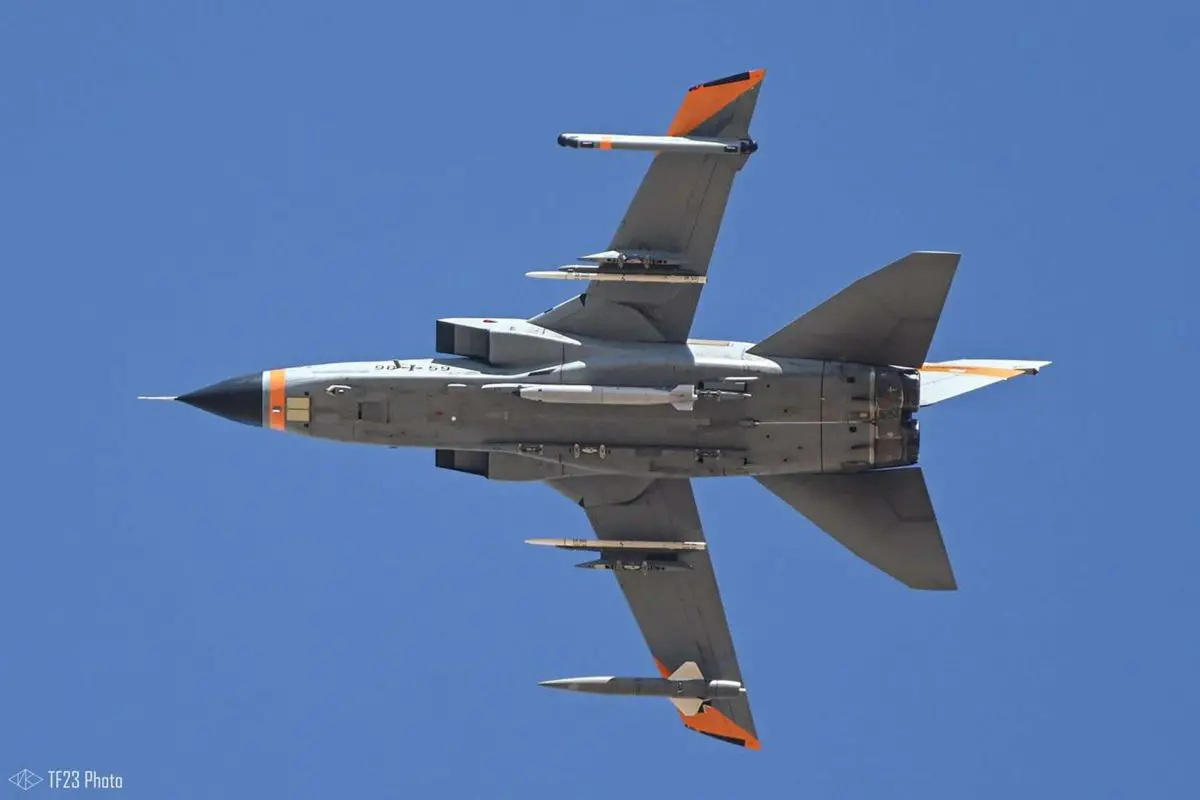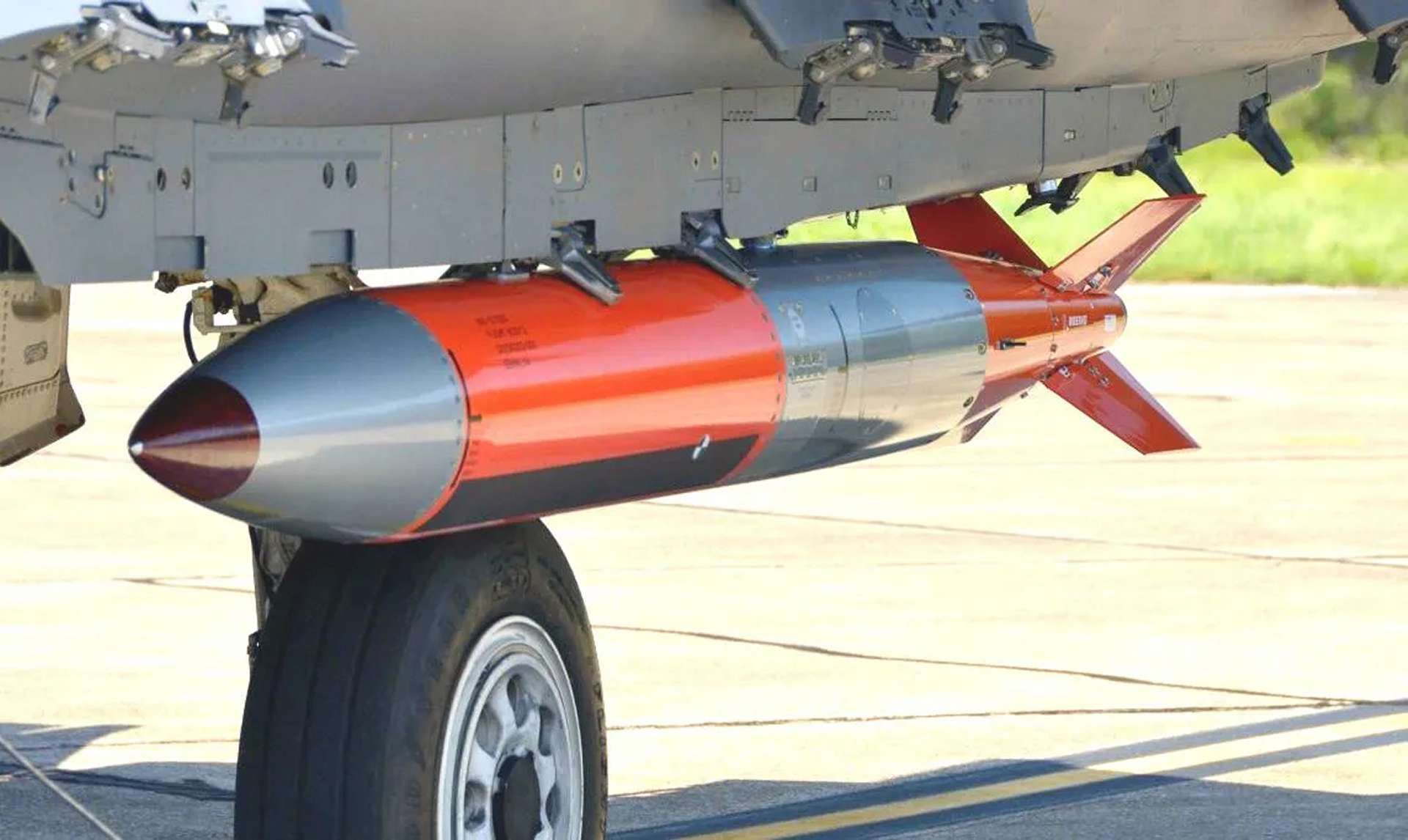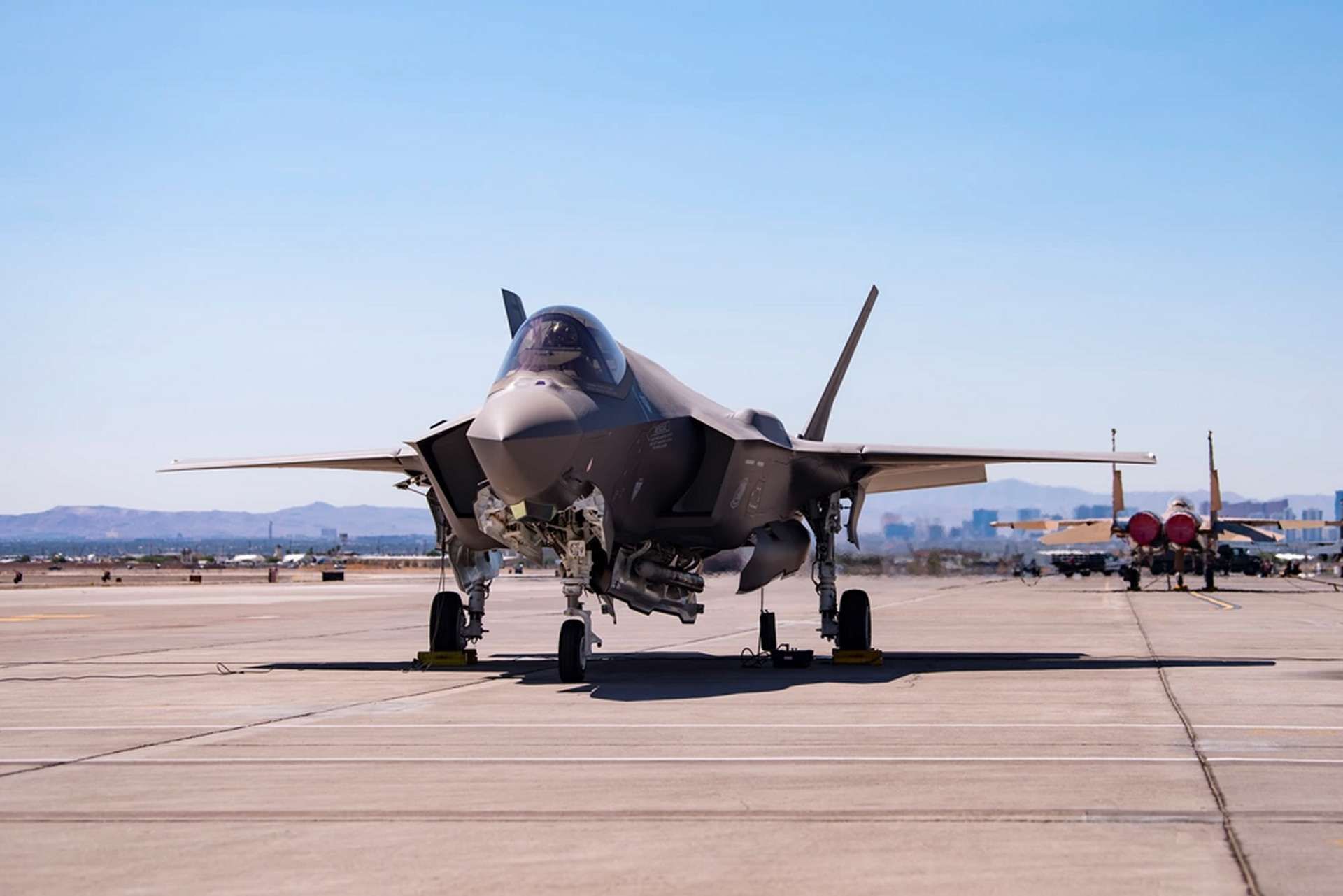Breaking News
German Tornado strike aircraft trains with latest US B61-12 thermonuclear bomb in California.
On September 3, 2024, TaskForce23 observed a Panavia Tornado, a multi-role combat aircraft operated by the German Air Force (Luftwaffe), returning to Edwards Air Force Base, a United States Air Force facility in California. The aircraft, identified by registration number 98+59, appeared to be carrying a B61-12 thermonuclear bomb. However, it is likely that the weapon was a training device or part of a Joint Test Assembly (JTA) flight test, rather than a live nuclear warhead.
Follow Army Recognition on Google News at this link

The observed device was possibly used for captive carriage tests, such as limit cycle oscillation tests, rather than separation tests, as indicated by the absence of fiducials. (Picture source: Twitter/TaskForce23)
According to the U.S. National Nuclear Security Administration (NNSA), a Joint Test Assembly (JTA) flight test is conducted to gather data on the reliability, accuracy, and performance of the United States' nuclear deterrent under conditions that mimic operational use, without involving nuclear explosives. These tests are a collaborative effort between the Department of Defense and the NNSA, supporting the assessment of the nuclear triad's delivery systems, which include bomber aircraft, land-based intercontinental ballistic missiles, and submarine-launched ballistic missiles. JTA flight tests utilize two types of assemblies: instrumented, which are equipped with telemetry systems to collect performance data, and high-fidelity, which validate the systems' functional performance. Data collected through telemetric monitoring across launch, flight, and reentry is essential for ongoing surveillance, qualification processes, and the development of weapon systems.
The sighting of the Tornado carrying a likely inert, production-representative version of the B61-12 is considered a reflection of collaboration between NATO allies and the United States to maintain the aircraft's compatibility with modern nuclear capabilities. The observed device was possibly used for captive carriage tests, such as limit cycle oscillation tests, rather than separation tests, as indicated by the absence of fiducials. While live nuclear weapons can technically be transported between bases, this generally occurs only under specific circumstances, usually when preparing for potential operational use.
The B61-12 is the latest variant in the B61 series of nuclear bombs, which has been in service since 1968. It has been developed under a Life Extension Program (LEP) aimed at extending the bomb's service life by 20 years through the refurbishment and replacement of aged components. The program, which involves modifying 400 bombs at a cost of $7.6 billion, is scheduled for completion by 2025. The B61-12 is designed for both strategic and tactical use and incorporates a two-stage radiation implosion design that allows for variable yield settings to adapt to different mission requirements.

The B61-12 thermonuclear bomb has been developed under a Life Extension Program (LEP) aimed at extending the B61 bomb's service life by 20 years through the refurbishment and replacement of aged components. (Picture source: US Air Force)
The B61-12 measures 6.4 meters in length and weighs approximately 374 kilograms. It is equipped with a new tail kit guidance assembly and an inertial navigation system (INS) to enhance its strike precision. The bomb offers four yield options, ranging from 0.3 kilotons to 50 kilotons, allowing adjustments in detonation strength based on mission needs. At its maximum yield, the B61-12 could impact a small to medium-sized city or a fortified military target, while at lower yields, it is capable of targeting smaller military objectives with reduced collateral damage.
The B61-12's modernization was initiated under the Obama administration to consolidate and replace several older models, including the B61-3, -4, -7, and -10, into a single variant with improved safety, security, and accuracy features. Production began in November 2021 and is planned to continue through the end of fiscal year 2025, with an estimated total cost of $9.6 billion. This effort is part of broader U.S. objectives to update its nuclear capabilities in response to security concerns related to other nuclear-armed states, such as Russia and China.
The B61-12 is characterized by its variable-yield capability, which allows its explosive power to be adjusted from 0.3 to 50 kilotons, depending on operational requirements. It also includes a precision guidance system designed to improve accuracy over previous versions. The B61-12 is considered a potential replacement for other nuclear weapons, including the high-yield B83-1 and the B61-11, which is designed for deep penetration. Additionally, a newer B61-13 variant is under consideration for targets that are more heavily fortified or larger in scale.

Several aircraft have been certified or are in the process of being certified to carry the B61-12, including the B-2 Spirit bomber, the F-35A Lightning II, the F-15E Strike Eagle, and several models of the F-16. (Picture source: US DoD)
Several aircraft have been certified or are in the process of being certified to carry the B61-12, including the B-2 Spirit bomber, which features systems like the Radar Aided Targeting System (RATS) to maintain targeting capabilities in environments where GPS may not function effectively. Other certified aircraft include the F-35A Lightning II, the only variant of the F-35 family approved for nuclear missions, the F-15E Strike Eagle, and several models of the F-16. NATO allies' aircraft, such as the PA-200 Tornado, are also certified to carry the B61-12. These platforms contribute to a dual-capable force that supports traditional strategic deterrent capabilities, such as intercontinental ballistic missiles (ICBMs) and ballistic missile submarines.
The observation of the Panavia Tornado carrying what appeared to be a B61-12 reflects the aircraft’s continuing operational role within NATO forces. The Tornado, developed by a consortium consisting of British Aerospace (later BAE Systems), MBB of West Germany, and Aeritalia of Italy, first flew on August 14, 1974, and entered service in 1979. Designed for versatility, the aircraft is capable of performing a range of missions, including low-level strike operations and air defense. It has been deployed in multiple conflicts, such as the Gulf War, the Kosovo War, and operations in Iraq, Afghanistan, and Libya.
The Tornado's design includes a twin-engine, variable-sweep wing that allows for effective operation at both low and high speeds, relevant for its role in penetrating air defenses at low altitudes. The aircraft is equipped with a fly-by-wire system, advanced avionics, and various sensors that enable it to operate under different weather conditions. Its wings can sweep between 25 and 67 degrees, optimizing for different flight profiles. The Tornado is powered by two Turbo-Union RB199 engines designed for supersonic speeds and equipped with thrust reversers to assist with short take-offs and landings (STOL).

The German Luftwaffe initially acquired 210 IDS and 35 ECR variants, with 94 IDS and 28 ECR aircraft remaining in service as of 2018, including the 98-59 used in California. (Picture source: JetPhotos/Timo Frisch)
There are three primary variants of the Tornado: the Interdictor/Strike (IDS) version, used for low-level, high-speed penetration strikes; the Electronic Combat/Reconnaissance (ECR) version, specialized for the Suppression of Enemy Air Defenses (SEAD); and the Air Defence Variant (ADV), which serves as an interceptor. Each variant has undergone various upgrades to maintain and extend operational capabilities.
The Tornado has been primarily operated by the air forces of Germany, Italy, the United Kingdom, and Saudi Arabia. The German Luftwaffe initially acquired 210 IDS and 35 ECR variants, with 94 IDS and 28 ECR aircraft remaining in service as of 2018. The Italian Air Force received 100 IDS Tornados, 18 of which were converted to ECR variants, and leased 24 ADV aircraft from the Royal Air Force between 1995 and 2004. The Royal Saudi Air Force purchased 96 IDS and 24 ADV aircraft, with 81 IDS aircraft remaining in service as of 2018. The UK Royal Air Force, once the largest operator, took delivery of 385 Tornados, including 230 GR1s, 18 F2s, and 147 F3s, before retiring the GR4 variant in 2019.
The Tornado GR4 variant, extensively used, has a crew of two and measures 16.72 meters in length, with a wingspan of 13.91 meters at a 25-degree sweep. It is powered by two Turbo-Union RB199 engines, each providing 76.8 kN of thrust with afterburner, enabling a maximum speed of Mach 2.2 (approximately 2,400 km/h). The aircraft's range is 1,390 kilometers, extendable to 3,890 kilometers with external fuel tanks. It can carry a maximum payload of 9,000 kilograms, including a variety of munitions such as AIM-9 Sidewinder or AIM-132 ASRAAM missiles, Brimstone air-to-surface missiles, Storm Shadow cruise missiles, Paveway series laser-guided bombs, and nuclear weapons like the B61 bomb. The Tornado is also equipped with a Mauser BK-27 revolver cannon for air combat.

The Tornado, developed by a consortium consisting of British Aerospace (later BAE Systems), MBB of West Germany, and Aeritalia of Italy, first flew on August 14, 1974, and entered service in 1979. (Picture source: Army Recognition)


























